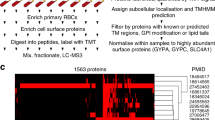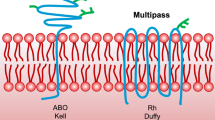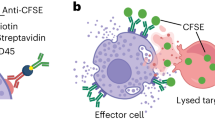Abstract
MEMBRANE antigens are extensively studied on different mammalian cell lines. Antigens of the erythrocyte series are often chemically well defined heterosaccharide determinants1, the subject of numerous studies, most of them restricted to the mature circulating erythrocytes. There are only a few reports dealing with the detection of blood group antigens on erythrocyte precursor cells2–5. Yunis and Yunis2 gave strong evidence of the presence of A, B and H alloantigens on human normoblasts, mostly by indirect agglutination methods involving living bone marrow cells.
This is a preview of subscription content, access via your institution
Access options
Subscribe to this journal
Receive 51 print issues and online access
$199.00 per year
only $3.90 per issue
Buy this article
- Purchase on Springer Link
- Instant access to full article PDF
Prices may be subject to local taxes which are calculated during checkout
Similar content being viewed by others
References
Race, R. R., and Sanger, R., Blood Groups in Man (Davis, Philadelphia, 1968).
Yunis, J. J., and Yunis, E., Blood, 22, 53 (1963).
Furasawa, M., and Adachi, H., Expl. Cell Res., 50, 497 (1968).
Borsook, H., Ratner, K., and Tattrie, B., Nature, 221, 1261 (1969).
Minio, F., Howe, C., Hsu, K. C., and Rifkind, R. A., Nature new Biol., 237, 187 (1972).
Reyes, F., Lejonc, J. L., Gourdin, M. F., Ton That, H., and Breton Gorius, J., C.r. hebd. Séanc Acad. Sci., Paris, 277, 1829 (1973).
Mollisson, P. L., Blood Transfusion in Clinical Medicine (Blackwell Scientific Publications, Oxford, 1967).
Avrameas, S., and Ternynck, T., Immunochemistry, 6, 53 (1969).
Masseyeff, R., Gombert, J., and Josselin, J., Immunochemistry, 2, 177 (1965).
Fine, J. M., and Steinbuch, M., Rev. Eur. Et. Clin. Biol., 15, 1115 (1970).
Avrameas, S., and Ternynck, T., Immunochemistry, 8, 1175 (1971).
Graham, R. C., and Karnosky, M. J., J. Histochem. Cytochem., 14, 291 (1966).
Bessis, M., Cellules du sang normal et Pathologique (Masson, Paris, 1972).
Bessis, M., and Breton Gorius, J., Nouv. Revue fr. Hémat., 1, 529 (1961).
Matter, A., Lisowska-Bernstein, B., Ryser, J. E., Lamelin, J. P., and Vassali, P., J. exp. Med., 136, 1008 (1972).
Gurner, B. W., and Coombs, R. R. A., Vox Sang., 3, 13 (1958).
Voak, D., and Williams, M. A., Br. J. Haemat., 20, 9 (1971).
Bretton, R., Ternynck, T., and Avrameas, S., Expl. Cell Res., 71, 145 (1972).
Author information
Authors and Affiliations
Rights and permissions
About this article
Cite this article
REYES, F., LEJONC, J., GOURDIN, M. et al. Human Normoblast A Antigen seen by Immunoelectron Microscopy. Nature 247, 461–462 (1974). https://doi.org/10.1038/247461a0
Received:
Issue Date:
DOI: https://doi.org/10.1038/247461a0
Comments
By submitting a comment you agree to abide by our Terms and Community Guidelines. If you find something abusive or that does not comply with our terms or guidelines please flag it as inappropriate.



